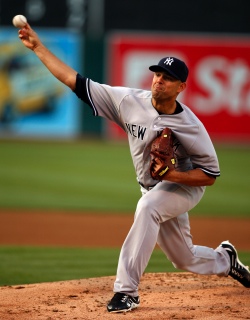
The patience the Yankees have shown with Javier Vazquez, it appears, has paid off. His excellent start last night was not only his eighth quality start of the season, but also the sixth time he’s pitched seven innings. That’s an invaluable contribution for a Yankees team that has some question marks in the bullpen. The timing of his turnaround also came at an excellent time, when A.J. Burnett slipped. He has been a stabilizing force in the rotation, something that seemed unlikely the last time Javy pitched in Oakland, back on April 20.
After starting the season with two poor performances against two of the AL’s better teams, Vazquez needed to put together a quality outing in Oakland. As he began the game it looked like he might do just that. Two of the four batters he faced in the first whiffed at strike three, and while he allowed at least one baserunner in each of the first five innings he still held the A’s to just one run, a lead-off shot by Travis Buck to lead off the fifth.
Things took a turn for the worse in the sixth. Javy struck out Ryan Sweeney to open the frame, but a single and a homer put the A’s within three. That was it for Vazquez, who labored enough through the first five innings that he ran his pitch count over 100, 107 to be precise, with just one out in the sixth. Considering Javy had thrown just 98 and 100 pitches in his previous two starts, Girardi gave him the hook. The Yanks went on to win the game, but all the baserunners, along with Javy’s inability to finish the sixth, had some still worried. It didn’t help that Javy got rocked in his next start.
In terms of results, Vazquez had a much better return trip to Oakland. He allowed just five baserunners in seven innings last night, while he allowed nine in 5.1 innings last time. He prevented the home run this time, whereas he let two leave the park last time. He was also much more efficient, using 110 pitches to complete seven where he used 107 to complete 5.1 last time. All of this, combined with the two-earned-run difference, makes it tough to call this start in any way worse than his last one. Yet there were a few concerning aspects of his pitch data.
On April 20 Javy got 11 swinging strikes out of 107 pitches, or 10.3 percent, leading to six strikeouts. Last night he generated just four swinging strikes in 110 pitches, 3.6 percent, which led to two strikeouts. That meant more balls in play, and with Javy it means more fly balls. The difference, of course, is that two of the A’s nine fly balls in April left the park, while none of their 12 did last night. Javy did get pretty unlucky in terms of fly balls leaving the park earlier in the year, but even at his best he’s going to allow at least one homer for every 10 fly balls. That’s why strikeouts become important for Vazquez.
It can’t be purely luck, though, that Vazquez kept all 12 fly balls inside the park last night. In both starts he threw a lot of fastballs high in the zone, which will certainly lead to more fly balls. There was a difference, however, in the vertical break of his four-seamer. On April 20th it was at 7.75, a below average mark. Last night it was at 9.27, a vertical break that works more in the pitcher’s favor. The vertical break, remember, is the “rise” of the ball compared to a theoretical ball with no spin. It was part of the reason the A’s weren’t able to make quality contact off Vazquez, and probably a good reason why none of those high fastballs left the park.
Another difference, not only last night but in Javy’s turnaround in general, is the effectiveness of his changeup. In his first start against the A’s he threw it 19 times, but only eight for strikes and only one swinging. The pitch averaged 81.36 mph against his 88.89 average fastball, had 7.48 inches of break towards righties, and 4.95 inches vertical break — again, against the 7.75 on the fastball. Last night the pitch averaged 80.76 mph against an 89.18 mph fastball, so he did realize a bit more separation. The vertical break was up to 6.05 against the 9.27 for the fastball, so again there was more separation. He got more horizontal break, 8.34 inches into righties. But most importantly he threw it for strikes, 14 of 25, and generated two swings and misses, half his total for the night.
The movement differences appear to be across the board. Here are the breakdowns from the April 20th start and the July 5th start, courtesy of Brooks Baseball. Click for larger images.
April 20:

July 5:

Almost everything other than swinging strikes looks better. That includes velocity, movement, and number of strikes.
Because of his monumentally terrible start, there will still be reservations about Vazquez. Fans will still claim that he can’t handle the pressure of New York and will still expect the worst when he starts. As he has shown, though, he’s a much different pitcher than he was earlier in the year. He’s getting much better movement on all of his pitches, and has even recovered some, but not all, of his velocity. We can say now that Vazquez is a solid No. 3 pitcher, which goes well with the rest of the staff. We could see quite the pitching show in the second half.
Leave a Reply
You must be logged in to post a comment.